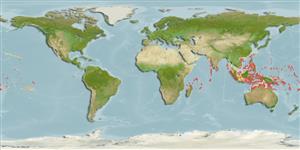Common names from other countries
Environment: milieu / climate zone / depth range / distribution range
Ecología
marino asociado a arrecife; rango de profundidad 3 - 30 m (Ref. 11790). Tropical; 28°N - 18°S
Indo-Pacific: East Africa to the Hawaiian and Society islands.
Tamaño / Peso / Age
Maturity: Lm ? range ? - ? cm
Max length : 10.0 cm SL macho / no sexado; (Ref. 48637)
Espinas dorsales (total): 0; Radios blandos dorsales (total): 64-70; Espinas anales 0; Radios blandos anales: 51 - 47; Vértebra: 40 - 41. Body mottled brown with irregular dark and pale markings; 2-3 dark-edged ocelli along lateral line pectorals blackish distally; dorsal and anal fins with minute black dots; caudal fin with black spots (Ref. 6270). Gill rakers rudimentary (Ref. 1602).
Inhabits coral heads of lagoon and seaward reefs; common in shallow caves or under ledges and can lie flat against vertical rock surfaces (Ref. 1602, 48637). Found in rubble slopes in sand or fine-rubble patches (Ref. 9792). Benthic (Ref. 58302). Comes out at dusk and hunts on low reef. It has low profile and crawls along like a flatworm, but activity waves its black pectoral fin as it goes (Ref. 48637). Feeds on small benthic animals (Ref. 9792).
Life cycle and mating behavior
Madurez | Reproducción | Puesta | Huevos | Fecundidad | Larva
Randall, J.E., G.R. Allen and R.C. Steene, 1990. Fishes of the Great Barrier Reef and Coral Sea. University of Hawaii Press, Honolulu, Hawaii. 506 p. (Ref. 2334)
IUCN Red List Status (Ref. 130435)
CITES (Ref. 128078)
Not Evaluated
Threat to humans
Harmless
Human uses
Pesquerías: sin interés
Más información
ReferenciasAcuiculturaPerfil de acuiculturaRazasGenéticaElectrophoresesheritabilidadEnfermedadesProcesamientoMass conversion
Herramientas
Warning: mysqli::__construct(): (HY000/1040): Too many connections in /var/www/html/includes/speciessummary.lib.php on line 2414
Can't connect to MySQL database fbquizv2. Errorcode: Too many connections
